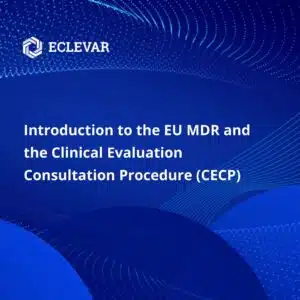What are the major changes introduced by the EU MDR compared to previous regulations?
The Regulation EU 2017/745, commonly known as the Medical Device Regulation (MDR), came into effect on May 26, 2021, bringing with it new requirements for clinical and post-market data for medical devices in Europe. One significant addition was the implementation of the Clinical Evaluation Consultation Procedure (CECP) as an extra level of scrutiny for specific devices.
The CECP ensures that notified bodies accurately assess the quantity and quality of clinical data for class III implantable devices and class IIb active devices intended to administer or remove a medicinal product. Read more about the EU MDR CECP requirements below.
Initiating the EU MDR CECP Process
When the CECP is consider applicable by a notified body, the process starts through the coordination of the European Medicines Agency (EMA). The EMA supervises ten expert panels, each specializing in distinct medical fields such as cardiovascular health and orthopaedics.
Upon receiving the relevant documents, the screening panel associated with the respective expert panel reviews them and decides, within 21 days, as to whether a full consultation is necessary. Should a full consultation be required, the expert panel is tasked with delivering a scientific opinion within 60 days.
During this evaluation, the expert panel scrutinizes the novelty of the device, substantial changes in the benefit-risk profile, or a significantly increased rate of serious incidents reported for specific groups of devices.
Exemption Criteria for CECP
To provide clarity on the devices exempt from the EU MDR CECP, Article 52(2) and the guidance document MDCG 2019-3 issued by the Medical Device Coordination Group (MDCG) establish three key criteria:
- Certificate renewal: Devices holding a certificate issued under the MDR may be exempt from the CECP.
- Unchanged benefit-risk profile: If a manufacturer modifies an already marketed device with the same intended purpose without negatively impacting its benefit-risk profile, it may be exempt.
- Compliance with common specifications: If the notified body confirms compliance with relevant applicable common specifications for the clinical evaluation of a particular device, it may be exempt from the CECP.
Annual Overview and Published Scientific Opinions
Article 52(4) mandates that the European Commission compiles an annual overview of devices subjected to the EU MDR CECP. The inaugural annual overview, published in January 2023, encompassed notifications submitted from April 2021 to June 2022. During this period, only eight notified bodies submitted a total of 215 notifications under Article 54(3). Surprisingly, the CECP was requested in a mere 24 cases.
All scientific opinions resulting from the CECP process are publicly accessible on the Commission’s website. As of now, five of the ten expert panels have published ten scientific opinions. In each of these opinions, the expert panels diverged from the notified body’s assessment of clinical data. Nevertheless, there were instances where the panel agreed with the final acceptance of the benefit-risk ratio, thereby allowing the device to be placed on the market.
Addressing Key Issues in Scientific Opinions
Multiple scientific opinions shed light on significant concerns raised by different expert panels. Some of the key issues addressed include:
- Pre-market clinical data: Inadequate pre-market clinical data resulted in a challenge to the expected lifetime of resorbable implants. The study period and Post-market Clinical Follow-up (PMCF) Plans were often deemed insufficient in certain cases.
- State of the art: Manufacturers failed to conduct thorough literature searches to determine the current state of the art. Consequently, the overall benefit-risk conclusions drawn by the expert panels could not always be supported.
- Quality of clinical evidence: Methodological flaws and limitations were identified in clinical investigation reports. The Clinical Evaluation Report (CER) and Clinical Evaluation Assessment Report (CEAR) frequently neglected to identify and address these flaws, thereby raising questions about the comprehensibility of the benefit-risk conclusion.
- PMCF: The adequacy of PMCF Plans in relation to available clinical evidence and the device’s projected lifetime came under scrutiny in several opinions.
Key Takeaways for Medical Device Companies
Based on the published scientific opinions, medical device companies can draw several key takeaways to enhance their practices:
- The inclusion of all system components in a single Clinical Evaluation Report (CER) should be prioritized, while avoiding the inclusion of multiple devices that are not part of the same system in one CER.
- It is crucial to identify and include all relevant favourable and unfavourable clinical data in the clinical evaluation. In some cases, expert panels may undertake their own literature searches.
- Expert panels place particular importance on the adequacy of planned PMCF activities, especially concerning indications and the projected device lifetime.
Manufacturers should expect challenges from the notified body if deviations occur from a pre-market clinical investigation plan and the CE mark is submitted before the investigation concludes.
Conduct rigorous literature searches, employing established methodologies such as Preferred Reporting Items for Systematic Reviews and Meta-Analyses (PRISMA) or patient/population, intervention, comparison, and outcomes (PICO).
The published scientific opinions represent a valuable resource for manufacturers and notified bodies in future clinical evaluations and assessments. Expert panels serve as the apex of clinical expertise at the EU level.

